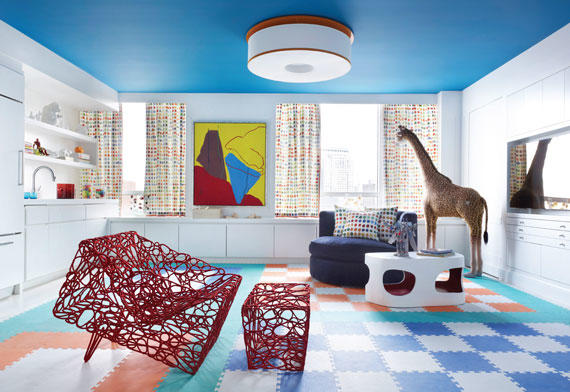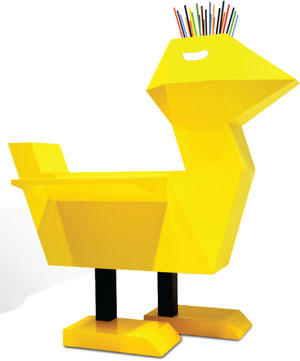Trending
No kidding around
Experts make case for spending more on responsibly created kid’s furnishings

It may seem counterintuitive to urge parents to seek out objects of quality and permanence, like upholstered furniture, even fine art, to go in — of all places — a child’s room. After all, children are the very opposite of permanence, capable of outgrowing sneakers before a season is over, to the eternal frustration of parents everywhere.
But what’s often available from manufacturers in today’s throwaway world can be shoddy and even harmful to the environment, and last about as long as a pair of sneakers. So choosing quality furnishings means, in many cases, choosing furnishings that are also ethically made and environmentally safe.
That’s an imperative for Jennifer Morris of JMorris Design, who will often try to steer clients away from “disposable” furniture and toward pieces that can be passed on.
“When I think about luxury, I think about using your money as a means to represent your commitment to an ethical society,” said Morris. “I believe strongly in purchasing responsibly. It’s a very important way to make an impact.”

The designer said that in order to get to desirable price points, children’s furniture manufacturers often create disposable products using what she calls “immoral” methods for getting the products made and often cut corners in construction.
“A crib should not last for only one child. If it’s really made well, it should be able to serve several, and when your family outgrows it, it should be able to be passed on to another family,” Morris said.
She recommends that parents be diligent and seek out something creative that is made locally or, if buying furniture that is made internationally, “try to make sure that the person is being paid a living wage and is part of a system that supports them.”
She favors brands like ducduc, a Connecticut manufacturer that has a showroom at the New York Design Center and makes cribs and dressers using finishes with low VOC, or volatile organic compounds, which are solvents that can be released into the air. The company uses solid wood and avoids MDF, medium-density fiberboard, an engineered wood product. Cribs run from $1,000 to $2,400 while kids’ dressers and armoires run $1,000 to $1,650.

Tree Bookcase, $899 at www.nurseryworks.net
Another favorite source of Manhattan interior designers is kinder Modern, which seeks out children’s design pieces from the 1920s to 1980s. According to kinder Modern’s web site, it offers furnishings “created by or in the style of prominent and iconic designers of the 20th century and are unique in their innovative use of materiality and design for the time.” Kinder Modern goods are available on the shopping site 1stdibs.com. A set of six Italian children’s enameled metal and plywood chairs, circa 1960, are offered for $2,500.
“Downtown Chic,” a decorating book by Robert and Cortney Novogratz, who are the subject of this month’s cover story, extolls the thrill of a vintage find at a flea market or thrift shop. While the lesson is not explicitly one of sustainability, the takeaway is.
Choosing sustainably made products avoids one of the pitfalls of mass-made furnishings. “Anything highly chemical ‘off-gases,’” Morris explained. “When you wonder, ‘how is this piece of furniture $99?’ it is because it is made with the least expensive glue and the cheapest labor.”
For some of interior designer Philip Gorrivan’s clients, concerns about allergies and respiratory issues guide their decision making. He seeks out organic and natural materials for textile products for those projects.
Selecting furnishings for a child’s room is on the same continuum as other health issues, he said.
“It’s caring about not only what children are eating, but how they are sleeping and breathing and developing,” he said.

Italian Child’s Chairs from kinder Modern, $2,500 at www.1stdibs.com
Another route to quality kids’ furnishings is simply to shop where the grown-ups go. B&B Italia for example, offers child-sized versions of their iconic armchairs. Last year the company introduced the UP Junior. The pint-sized chair retails for $1,519, and like other upholstered products from B&B Italia, has a 10-year guarantee for the frame.
“Cutting down industrial recycling and disposal activities actually saves materials, energy and emissions,” said a company spokesperson.
Interior designer Sandra Nunnerley also endorses shopping for kids’ furniture at the same places adults go.
“We always look to include the same well-made furniture, custom-made window treatments and high-quality carpeting that we use in other rooms,” Nunnerley said.
Focusing on the value of the furnishings one incorporates into a child’s room also results in a well-designed room that can grow with a child. Nunnerley advocates putting high-quality custom upholstered furniture and interesting artwork in a children’s room for just that reason.
An initial investment in a classic bed, light fixture, window treatment and so on means the room doesn’t require a complete redecoration for the transition to teenagedom.
“You want the room to continue to be used in the future, as the child matures and wants a more sophisticated space to relax with friends,” she said. “I love to use color boldly in a child’s room, creating happy, cheerful spaces. In a little girl’s room, we made it so pretty and feminine by using pinks and yellows in the window treatments, along with luxurious bed linens.”
That same room, she explained, could be “stripped” later of its “girly” elements.

Chicken Desk from kinder Modern, $16,000 at www.1stdibs.com
At a large Downtown apartment created by combining two homes, Nunnerley decorated a 400-square-foot playroom that contains a kitchen where the family’s nanny can prepare small meals. The space features an artwork by American artist Raymond Parker, a red chair and ottoman designed by Mali designer Cheick Diallo and a table by French designer Jacques Jarrige. There are also clever, shallow drawers under the television that hold the children’s artwork. A large blue chair swivels to catch the view. The room is airy and colorful.
But as Morris explained, getting clients to put their money where their mouth is can be a challenge. “Most projects are a mix of high and low,” she said. That’s partly a result of what it means to live in New York City.
“We lead such a transient life in New York City. We get married and we move, we have a child and we move again. So I tell my clients I can’t promise that every piece of furniture will fit their new space,” Morris added. “But there are several ways to recoup your investment: You can resell items online or in consignment shops. But you can only do this if you invest in them.”
That means you probably can’t resell that $99 piece of furniture, she said. It likely didn’t even survive the three hours spent setting it up.




